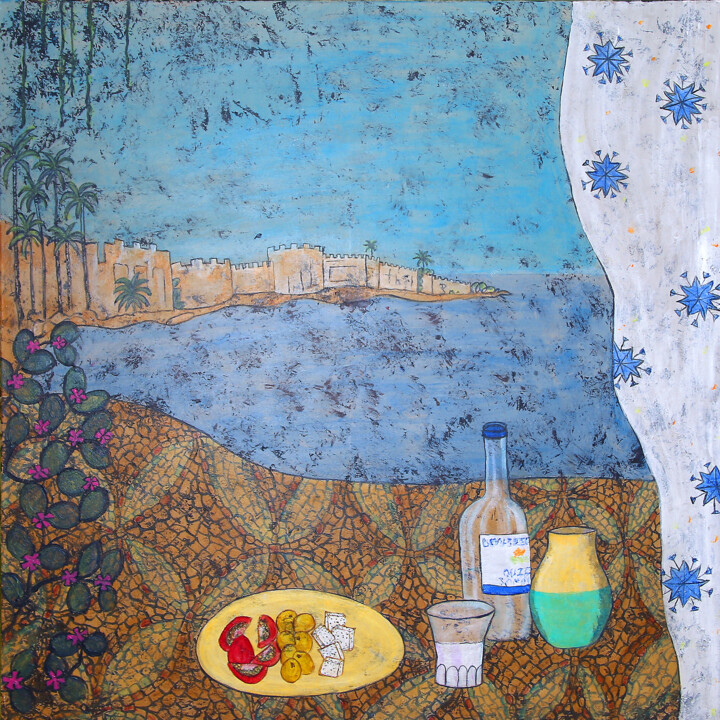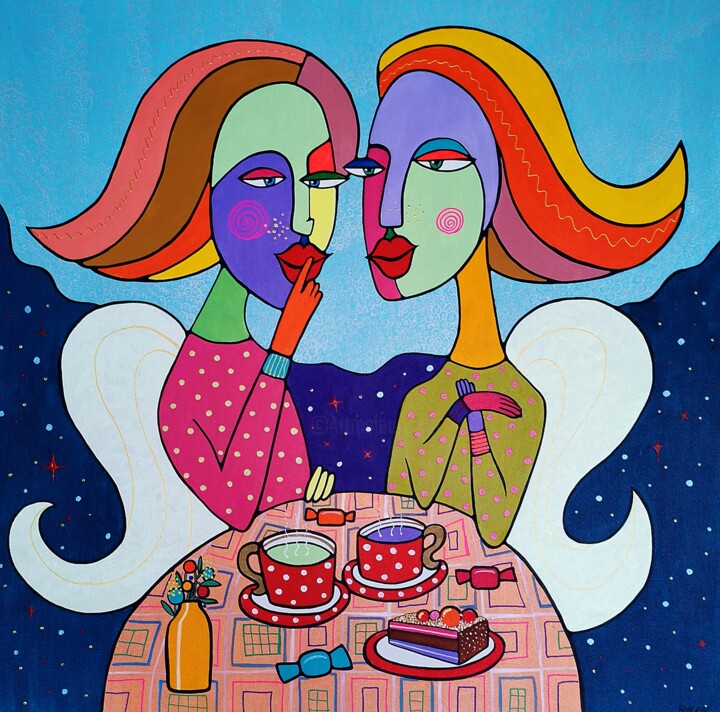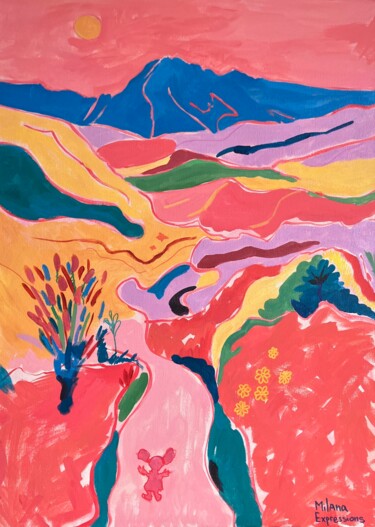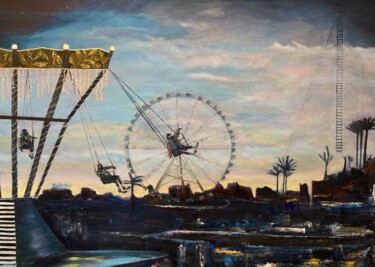18,585 Original artworks, Limited Editions & Prints:
How to define Naive Art style?
What is Naive art?
What is naive art, and how do you define naive art? Nave painting is a style of art that was started by artists like Henri Rousseau who didn't know much about art. Most of the time, nave art is defined as visual art made by someone who hasn't had the training and education that a professional artist does. When a professional artist tries to copy this style, it is often called "primitivism."
What is the definition of Naive art?
Nave art is usually defined as visual art made by someone who doesn't have the formal training and education that a professional artist does (in anatomy, art history, technique, perspective, ways of seeing). When a trained artist tries to copy this style, it is sometimes called primitivism, pseudo-nave art, or fake nave art.
Unlike folk art, nave art doesn't have to come from a specific popular cultural context or tradition. In fact, at least in advanced economies and since the Printing Revolution, it's impossible not to know about the local fine art tradition, which has spread through popular prints and other media. Naive artists know about "fine art" conventions like graphical perspective and compositional conventions, but they can't or don't use them to their full potential. Outsider art (also called "art brut"), on the other hand, refers to works that come from a similar background but have little to do with the mainstream art world.
Nave art is known for being simple and honest like a child, and this is why it is often copied. This kind of painting usually has a flat style of drawing and a simple way of showing depth. Henri Rousseau, a French Post-Impressionist who lived from 1844 to 1910 and was discovered by Pablo Picasso, was one of the most important painters of "naive art."
There has been some disagreement about what the term means and where it "ends" with other terms like folk art and outsider art. Nave art is usually used to describe works of fine art made by self-taught artists, like paintings and sculptures. Folk art, on the other hand, refers to things that can be used in everyday life. But this difference has been argued about. "Provincial" is another word that can be used, especially for paintings and buildings. It is mostly used to describe work by artists who have had some traditional training but whose work falls short of metropolitan or court standards by accident.
What are the characteristics of Naive art?
People often think of nave art as work by an outsider who hasn't had (or hasn't had much) training or a degree. Before the 20th century, this was true, but now there are schools for naive art. Naive art is now a fully recognized type of art that can be seen in galleries all over the world.
The features of nave art don't fit well with the formal aspects of painting, especially when the three rules of perspective aren't followed (as described by the Progressive Painters of the Renaissance):
- The size of things gets smaller as they get farther away,
- Colors change as you get farther away, -Details become less clear as you get farther away,
Here are the results:
- The effects of perspective are geometrically wrong (they look like children's drawings or paintings from the Middle Ages, but that's where the comparison ends).
- Strong use of pattern, unrefined color on all the plans of the composition, without enfeeblement in the background. -Equal attention to details, including those in the background that should be shaded off.
People say that naive art is easy to spot because it is not complicated. It has become so popular and well-known, though, that many examples could be called "pseudo-naive."
"Pseudo nave" or "faux nave" art is the work of an artist who is more imitative or self-conscious and whose work looks more copied than original. "Nave" art is the work of an artist who did not go to art school or academy, like Henri Rousseau or Alfred Wallis.
Since Autodidactism has become more popular as a way to learn in modern times, strict naiveté is not likely to be found in modern artists. Living artists don't always like naive categorizations, but this is likely to change as more dignifying signals become known. There are now museums for naive art in Kecskemét, Hungary; Kovaica, Serbia; Riga, Latvia; Jaen, Spain; Rio de Janeiro, Brazil; Vicq, France; and Paris. Gary Bunt, Lyle Carbajal, Gabe Langholtz, Gigi Mills, Barbara Olsen, Paine Proffitt, and Alain Thomas are all English-speaking living artists who admit to having a naive style.
"Primitive art" is another term that people who haven't studied art often use to describe it. Historically, though, it has been used more to describe art from cultures that Western academia has deemed "primitive" socially or technologically, like Native American, sub-Saharan African, and Pacific Island art (see Tribal art). This is different from the "primitive"-inspired, self-aware movement called "primitivism." Folk art is another term that is similar to nave art but not the same thing.
There are also the terms "navism" and "primitivism," which are usually used to describe professional painters who use nave art as their style (like Paul Gauguin, Mikhail Larionov, Paul Klee).
What are the characteristics of Naive paintings?
Nave art is sometimes used to describe art made by people with no professional training or degrees. Before the 20th century, this was true, but now there are academies for nave painting. Now, naive art is a well-known form of art that can be seen in galleries all over the world. The formal parts of painting are strangely similar to the things that make up nave art, especially when it comes to not following the three rules of perspective.
-As things get farther away, their sizes get smaller.
-As you move away from a color, it becomes less vivid.
-As you move away, details become less clear.
One of the results is that the effects of perspective are wrong from a geometric point of view. There is no weakening of the background in any of the composition's plans, and there are many patterns. The same amount of care was given to all of the details, even the ones in the background that should be darker.
People say that nave art is easy to recognize because it doesn't have a lot of details. But because it's become such a well-known style, many pieces can be put into the pseudo-nave or Primitivism categories. Autodidactism is becoming more popular as a way to learn, so strict naivety isn't something you see often in artists today.
Living artists may not always accept simple categorizations, but this is likely to change as more dignifying signals become available.
Discover original contemporary Naive Art Artworks on ArtMajeur
Original contemporary Naive Art is a type of artwork that features simple, childlike shapes, bold colors, and a lack of perspective. The main types of supports used in Naive Art are canvas, paper, and wood. The materials used to create these artworks can range from acrylic and oil paints to colored pencils and markers. What makes this type of original artwork unique is its ability to transport the viewer to a simpler time and evoke feelings of nostalgia and joy. Naive Art is often created by self-taught artists who have a raw, untrained talent that lends itself to a charming and endearing aesthetic. The result is a body of work that is refreshingly authentic and relatable.

©2025 Kosta Morr
Origins and History
Naive Art, also known as Primitive Art or Folk Art, is a genre of art that emerged in the late 19th century. Naive Art pieces are characterized by their simplicity, childlike imagery, and lack of formal artistic training. The movement’s name comes from the French word "naïf," meaning "naive" or "innocent." The earliest examples of Naive Art can be traced back to the 17th century, with the works of French artist Henri Rousseau being some of the most well-known. The movement gained popularity in the early 20th century, with artists such as Grandma Moses and Horace Pippin gaining international recognition for their work. Naive Art has continued to evolve throughout the years, with Contemporary Artists putting their own unique spin on the style. Today, Naive Art continues to be celebrated for its childlike charm and whimsical imagery.

©2023 Simon Grindrod
Evolutions of theses works in the contemporary art market
Original contemporary Naive Art has undergone a significant transformation in recent years, reflecting the changing tastes of the art market. This style of art, known for its childlike simplicity and lack of formal training, has evolved to encompass a wider range of themes and techniques. Artists are now exploring more complex subject matter, such as social issues and political commentary, while also experimenting with new mediums and textures.

©2025 Eva Hidalgo
Related Famous Artists
Contemporary artists who are recognized for their exceptional work in contemporary Naive Art include:
Andre Bauchant, a French artist who gained recognition for his lively and colorful paintings of landscapes and still-life compositions. Bauchant’s works express a sense of simplicity and innocence, reflecting the spirit of Naive Art.
Séraphine Louis, a French painter known for her unique style of painting, which is characterized by its strong use of color and bold brushstrokes. Louis’s works are often inspired by religious themes and nature.
Henri Rousseau, a French post-impressionist painter who is recognized as one of the pioneers of Naive Art. Rousseau’s works are characterized by their flatness, bold color, and simplified forms, which reflect his lack of formal training.
Nikifor Krynicki, a Polish painter known for his depictions of life in the Polish countryside. Krynicki’s works are characterized by their vibrant colors, playful compositions, and a sense of childlike innocence.
Grandma Moses, an American folk artist who gained recognition for her paintings of rural life in the United States. Moses’s works are characterized by their simplicity, bright colors, and charming depictions of everyday life.
These artists have made significant contributions to the contemporary Naive Art movement, and their works continue to inspire and captivate audiences around the world.

©2025 Daheaven Art
Notable original contemporary Naive Art artworks
"La Danse" painted by Haitian artist Hector Hyppolite in 1946, depicts a colorful and whimsical scene of dancers in traditional Haitian dress. The painting is filled with vibrant hues and intricate patterns, capturing the energy and joy of the dance.
"Tree of Life" by Nigerian artist Prince Twins Seven-Seven, created in 1984, features a densely populated and intricately detailed tree with a multitude of human and animal figures interwoven with its branches. The piece is a celebration of life and the interconnectedness of all living things.
"Le Coq" by French artist Henri Rousseau, painted in 1899, portrays a proud and regal rooster surrounded by lush foliage and exotic animals. The painting’s bold colors and flattened perspective are hallmarks of Rousseau’s naively stylized approach to painting.
"Self-Portrait with Thorn Necklace and Hummingbird" by Mexican artist Frida Kahlo, completed in 1940, is a haunting and deeply personal depiction of the artist’s physical and emotional pain. The painting features Kahlo wearing a thorn necklace and a dead hummingbird, symbolizing her physical suffering and the loss of her fertility.
"La Reve" by French artist Séraphine Louis, painted in 1927, is a dreamlike and otherworldly depiction of a fantastical garden. The painting’s swirling colors and ethereal quality capture the sense of wonder and mystery that permeates Séraphine’s work.

Daheaven Art
Acrylic on Canvas | 35.4x35.4 in

Milana Chtch
Acrylic on Canvas | 27.6x19.7 in

Laurent Mangepapier
Watercolor on Paper | 19.7x25.4 in

Sasha Robinson
Acrylic on Canvas | 19.7x27.6 in

Liana Asatryan
Acrylic on Canvas | 31.5x27.6 in

Milana Chtch
Acrylic on Canvas | 27.6x19.7 in

Claudio Mario Andrea
Acrylic on Canvas | 59.1x59.1 in

Milana Chtch
Acrylic on Canvas | 23.6x39.4 in

Elena Lanceleux
Acrylic on Canvas | 47.2x47.2 in

Jsroosenys
Acrylic on Canvas | 21.7x18.1 in


























